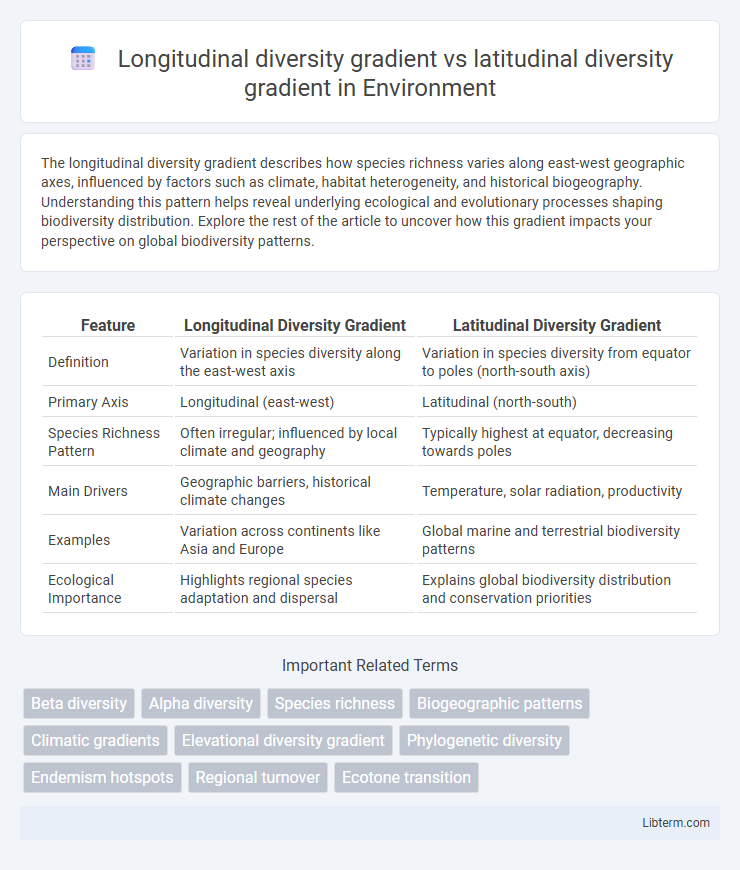The longitudinal diversity gradient describes how species richness varies along east-west geographic axes, influenced by factors such as climate, habitat heterogeneity, and historical biogeography. Understanding this pattern helps reveal underlying ecological and evolutionary processes shaping biodiversity distribution. Explore the rest of the article to uncover how this gradient impacts your perspective on global biodiversity patterns.
Table of Comparison
| Feature | Longitudinal Diversity Gradient | Latitudinal Diversity Gradient |
|---|---|---|
| Definition | Variation in species diversity along the east-west axis | Variation in species diversity from equator to poles (north-south axis) |
| Primary Axis | Longitudinal (east-west) | Latitudinal (north-south) |
| Species Richness Pattern | Often irregular; influenced by local climate and geography | Typically highest at equator, decreasing towards poles |
| Main Drivers | Geographic barriers, historical climate changes | Temperature, solar radiation, productivity |
| Examples | Variation across continents like Asia and Europe | Global marine and terrestrial biodiversity patterns |
| Ecological Importance | Highlights regional species adaptation and dispersal | Explains global biodiversity distribution and conservation priorities |
Introduction to Biodiversity Gradients
Biodiversity gradients illustrate the variation in species richness and composition across spatial dimensions. The latitudinal diversity gradient shows a consistent increase in species diversity from the poles to the equator, driven by factors like climate stability and energy availability. In contrast, the longitudinal diversity gradient highlights patterns of species distribution along east-west axes, influenced by historical land connections, ocean currents, and regional habitat heterogeneity.
Defining Latitudinal Diversity Gradient
The Latitudinal Diversity Gradient (LDG) describes the increase in species richness from the poles toward the equator, representing the most consistent and well-documented pattern in global biodiversity. It highlights how tropical regions support higher levels of species diversity compared to temperate and polar zones, influenced by factors such as climate stability, energy availability, and evolutionary history. This gradient contrasts with longitudinal diversity patterns, which vary less predictably across east-west axes and are often shaped by region-specific ecological and geological processes.
Understanding Longitudinal Diversity Gradient
The longitudinal diversity gradient describes the variation in species richness along east-west axes, unlike the more widely studied latitudinal diversity gradient, which varies north-south. This gradient is influenced by factors such as historical climate stability, ocean currents, and continental configurations that shape habitat availability and species dispersal. Understanding longitudinal diversity gradients enhances insights into biogeographic patterns and helps predict biodiversity responses to environmental changes across different longitudes.
Historical Perspectives on Biodiversity Patterns
The latitudinal diversity gradient, extensively documented since the 19th century, illustrates the increase in species richness from the poles to the equator, shaped by historical climate stability and evolutionary processes. In contrast, the longitudinal diversity gradient, though less studied, reflects species variation across east-west axes influenced by geological history, ocean currents, and habitat connectivity. Historical perspectives highlight that latitudinal patterns often result from global climatic shifts and glaciation events, whereas longitudinal gradients emphasize regional biogeographic barriers and dispersal limitations shaping biodiversity distribution.
Key Drivers Behind Latitudinal Diversity Gradient
The latitudinal diversity gradient (LDG), characterized by higher species richness near the equator and decreasing diversity toward the poles, is primarily driven by factors such as climate stability, energy availability, and evolutionary history. In contrast, longitudinal diversity gradients are less pronounced and often influenced by regional geographic barriers and habitat heterogeneity. Key drivers behind LDG include temperature, solar radiation, and consistent warm climates promoting higher metabolic rates, faster speciation, and reduced extinction rates in tropical regions.
Factors Influencing Longitudinal Diversity Gradient
The longitudinal diversity gradient is influenced by factors such as historical climate stability, habitat heterogeneity, and geographic barriers that limit species dispersal across longitude. Unlike the latitudinal diversity gradient driven primarily by solar energy and temperature gradients, longitudinal diversity patterns reflect complex interactions between topography, ocean currents, and evolutionary history. These elements shape species distribution by creating isolated environments and varying ecological niches along longitudinal axes.
Comparative Analysis: Latitude vs Longitude in Biodiversity
The latitudinal diversity gradient reveals a significant increase in species richness from the poles toward the equator, driven by factors like climate stability and productivity. In contrast, the longitudinal diversity gradient is less pronounced and varies regionally, influenced by historical landmass distributions and oceanic barriers. Comparative analysis shows latitude as a stronger predictor of biodiversity patterns globally, while longitude impacts localized species diversity due to geological and ecological variances.
Case Studies Highlighting Each Gradient
Longitudinal diversity gradients are exemplified by studies in the Amazon Basin, where species richness varies along the east-west axis due to climatic and geological differences, revealing patterns distinct from typical latitudinal gradients. Case studies in the Eastern Himalayas show latitudinal diversity gradients with species richness increasing toward the equator, driven by temperature and solar radiation variations. These examples highlight how geographic orientation influences biodiversity patterns, with longitudinal gradients shaped by regional environmental heterogeneity and latitudinal gradients by global climatic trends.
Implications for Conservation and Biogeography
The latitudinal diversity gradient, with species richness peaking near the equator and declining toward the poles, informs conservation priorities by highlighting tropical regions as biodiversity hotspots requiring urgent protection. The longitudinal diversity gradient, less pronounced but significant in certain taxa and ecosystems, emphasizes the role of historical biogeographic events and habitat fragmentation in shaping species distribution, suggesting tailored conservation strategies based on regional evolutionary history. Integrating both gradients enhances biogeographical models and improves the effectiveness of global conservation planning by addressing spatial and temporal patterns of biodiversity loss.
Future Research Directions and Challenges
Future research on longitudinal diversity gradients requires advanced spatial modeling techniques to disentangle the complex interactions between climate, topography, and species dispersal across different longitudes. Challenges include the uneven availability of biodiversity data along longitudinal transects and the need for integrative approaches combining remote sensing, genetic data, and ecological niche modeling. Comparative studies with latitudinal diversity gradients could clarify underlying mechanisms such as evolutionary history, climatic stability, and habitat heterogeneity, fostering predictive models for biodiversity responses to global climate change.
Longitudinal diversity gradient Infographic

 libterm.com
libterm.com